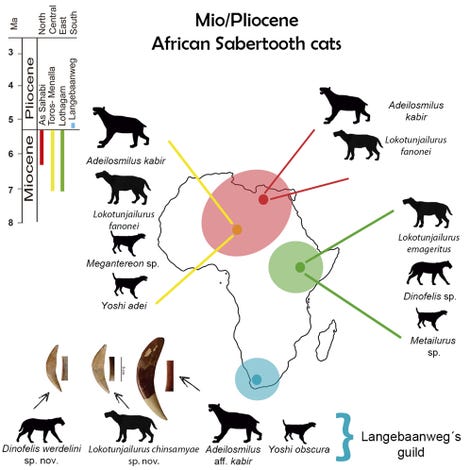Paleontologists recently revisited a trove of fossils found in a South African quarry and found two previously unknown species of sabertooth cats in their mix.
The 5.2-million-year-old cats are just the latest sabertooths known in Africa; the recent team of researchers also found two previously known species of cat in the fossil trove, though one had never been found in South Africa before.
Langebaanweg ‘E’ Quarry is an open-cast mine on the west coast of South Africa that opened in 1965, producing a surprising amount of vertebrate fossils. The fossils date to the boundary of the Miocene and Pliocene epochs, just over 5 million years ago.
The researchers took their feline data—measurements of the cats’ skulls, jaws, teeth, and so on—and produced a sabertooth family tree to determine how the cats are interrelated. The team’s research was published today in iScience.
“One of the possible implications of this research is that by studying the Langebaanweg assemblage of felidae, including sabertooth cats and caracal-like and serval-like felids, we have been able to infer that the environment was opening up,” said study co-author Alberto Valenciano, a paleontologist at Complutense University, in an email to Gizmodo.
The new species are Lokotunjailurus chinsamyae and Dinofelis werdelini. The previously known species are Adeilosmilus aff. kabir and—my personal favorite—Yoshi obscura. As an aside, the team that coined the genus Yoshi wrote in 2015 that the genus was “characterized by a round, short, and deep skull, and short canines that are somewhat transversely compressed but are not serrated.”
The team expected to find a new Dinofelis species based on previous research, but the discovery of a new Lokotunjailurus outside of Kenya and Chad was a surprise.
The presence of larger, generally faster sabertooth cats in South Africa suggests that the environment in the continent’s south was suited to them—a possible indication that at least some of the region was transitioning from a forest environment to a grasslands environment.
“Between 7 and 5 million years ago, Africa underwent a more continuous shift towards a more open, arid grassland or desert-like ecosystem from the late Miocene that continued into the Pliocene, in contrast to Europe and Asia,” Valenciano added. “The continuous aridification [drying out] throughout the Miocene and Pliocene, which includes the expansion of open environments, could be an important trigger of hominin bipedalism.”

Currently, we are not aware of any direct association between free-ranging felids in Africa and hominin evolution, but the research team posits that the same factors that allowed sabertooth cats to diversify and roam more of the content may have pushed hominins to become bipedal.
There’s no doubt that big cats like sabertooths and ancient hominins interfaced in the ancient past. Just last month, paleoanthropologists announced the discovery of a hominin leg bone that had been butchered by another hominin—possibly an early instance of cannibalism. But the bone also had teeth marks from big cats, indicating that the latter had come across the unfortunate hominin either before or after its death and butchering.
Saber teeth are a great adaptation for carnivorous animals because they allow predators to slice and shear flesh. In cat-on-cat violence, there’s even a gnarly fossil that suggests the animals used their sabers for puncturing.
There’s evidence for sabertooth mammals nearly 50 million years ago—a mere 16 million years after the extinction of all non-avian dinosaurs—with evidence suggesting these animals diversified over time. The teeth popped up across the mammalian tree of life; until several years ago a cow-eyed marsupial sabertooth, Thylacosmilus, roamed South America.
Though it’s not entirely clear why sabertooth cats went extinct after the Pleistocene, Valenciano said, “it has to be linked with environmental changes, and with the emergence of the social big-cats (lions), which become the top predator of such ecosystems.
“In the case of Africa, the sabertooth cats lived till the Pleistocene with forms such as Megantereon and coexisted with current pantherines like lions and leopards,” he added.
While we don’t know the specific death knell for the sabertooth trait in big cats, all is not lost. We still have the adorably fanged muntjac deer.
More: Saber-Toothed Marsupial Predator Compensated for Its Teeth With Cow Eyes
